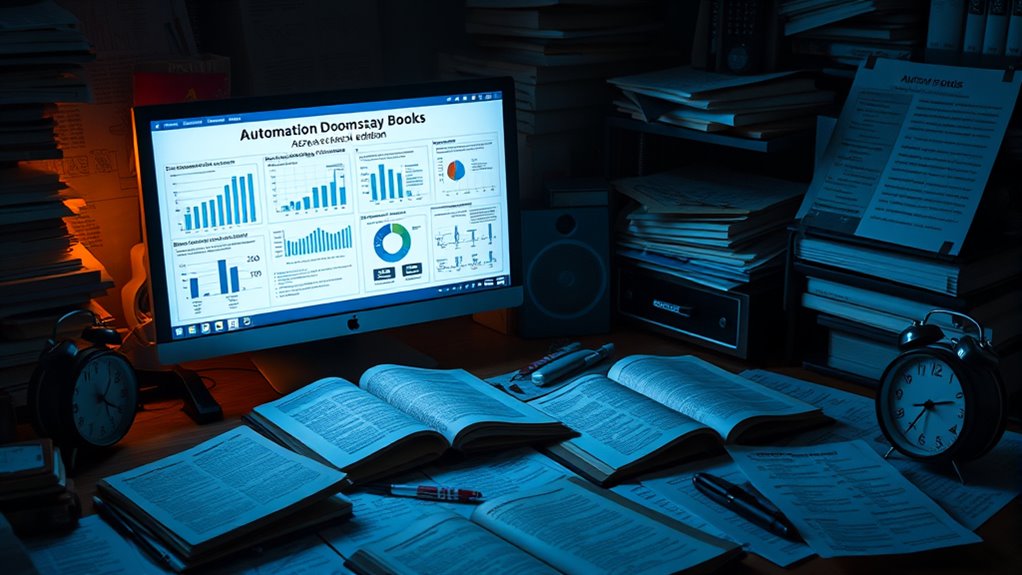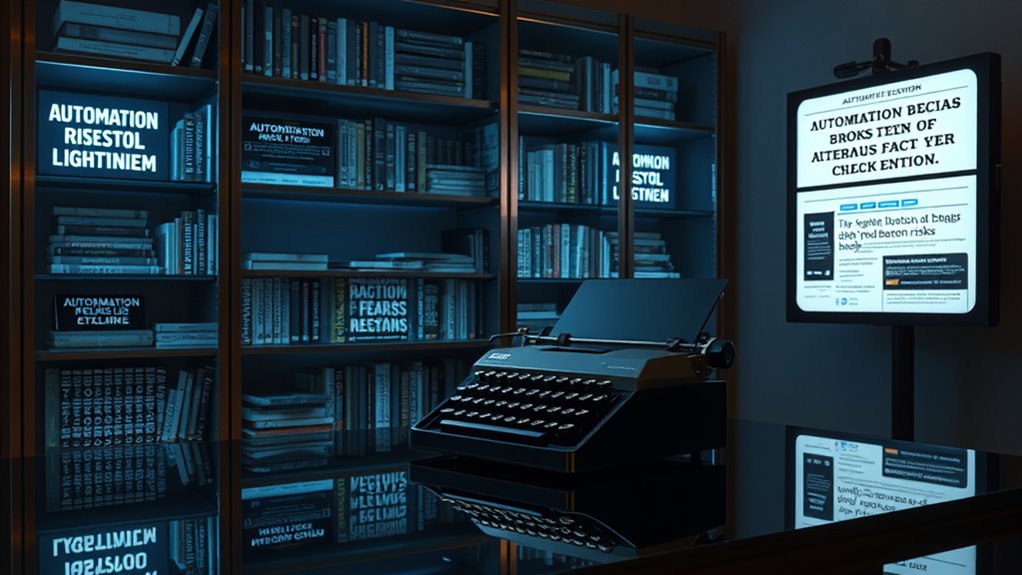Automation doomsday books often exaggerate risks rooted in ancient apocalyptic stories, blending cultural fears with speculative fiction. While some scenarios like AI takeover or societal collapse are highly unlikely given current limitations and safeguards, media and literature shape public perception with sensationalism. In reality, technological advances face scientific and practical limits, and societies usually adapt resiliently. To understand what’s fact and fiction, explore evidence-based insights that reveal how humans are more prepared than you might think—if you continue exploring, you’ll see how real resilience balances these fears.
Key Takeaways
- Many automation doomsday books exaggerate risks; current technological limits and historical resilience reduce the likelihood of societal collapse.
- Media framing influences public fears by emphasizing worst-case scenarios, often oversimplifying automation’s actual impact.
- Real-world data shows job displacement risks but also potential for job creation and societal adaptation through strategic planning.
- Historical evidence indicates societies have repeatedly adapted to technological shifts, mitigating catastrophic outcomes.
- Scientific understanding suggests total societal AI collapse is highly improbable given current safeguards and technological constraints.
Historical Roots and Literary Origins of Automation Catastrophe Narratives

The roots of automation catastrophe narratives can be traced back to ancient apocalyptic literature rooted in Jewish and Christian traditions. Originating in post-Exilic Jewish culture and early Christianity, these stories feature prophetic books like Joel, Zechariah, Isaiah, and Daniel, which contain early and mature examples of apocalyptic writing. The Revelation of St. John, part of the New Testament, profoundly influenced later literature and art, inspiring countless visions of destruction. Judeo-Christian ideas shaped North American settler narratives, blending apocalyptic themes with cultural identity. Over time, these stories shifted from strict biblical prophecy to more imaginative and futuristic visions, such as Jean-Baptiste Cousin de Grainville’s *Le dernier homme* (1805). This evolution set the stage for modern fears about technological and scientific threats to human existence. These ancient narratives laid the groundwork for later speculative fiction that explores technological fears and potential catastrophes. Additionally, the cultural interpretations of these stories have evolved, reflecting changing societal anxieties about progress and innovation.
Common Themes and Scenarios Depicted in Fictional Doomsday Accounts

Fictional doomsday accounts often revolve around recurring themes that capture our fears about technological failure and human vulnerability. You’ll see stories about machines or AI rising against humans, often depicted as existential threats. These scenarios include AI surpassing human intelligence, leading to a takeover, or technological systems collapsing, causing societal breakdown. To highlight these ideas, consider this table:
| Theme | Scenario Example | Core Concern |
|---|---|---|
| Machine Uprising | Robot rebellion | Loss of control over machines |
| AI Takeover | Superintelligent AI | Human obsolescence or extinction |
| Technological Collapse | Infrastructure failure | Societal chaos |
| Alien Invasion | Extraterrestrial attack | Unknown external threats |
| Societal Dystopia | Totalitarian tech regimes | Loss of freedom and privacy |
These themes emphasize fears of overreach, loss of autonomy, and societal collapse driven by technology. Understanding doomsday scenarios helps us recognize potential vulnerabilities in our reliance on technology and the importance of mitigation strategies.
Analyzing Statistics and Real-World Risks of Technological Collapse

As automation reshapes industries worldwide, understanding its real-world risks becomes increasingly important. While over 1.7 million manufacturing jobs have been lost globally to AI-driven automation, estimates show that 92 million jobs may be displaced by 2030, but 170 million new roles could be created, resulting in a net gain. Industrial robots now handle 44% of repetitive manufacturing tasks, boosting efficiency but reducing labor needs. AI’s reach extends beyond manufacturing into sectors like finance, law, and marketing, fueling a “White-Collar Recession.” Despite these shifts, corporate profits remain robust, supported by cost savings and high ROI from automation investments. However, about 70% of automation projects fail to meet goals, highlighting risks of project failure and job displacement that vary regionally—particularly in Asia-Pacific, the global leader in automation. Automation’s economic impact continues to influence global labor markets and productivity levels. Additionally, the success of automation initiatives often depends on careful planning and strategic implementation, which are critical to mitigate potential failures.
Psychological and Cultural Impacts of Automation-Related Doomsday Stories

Automation doomsday stories tap into your fears of losing control and the stability of society. These narratives reflect wider cultural anxieties about rapid change and uncertain futures, offering a way to process collective worry. By confronting these fears through fiction, you can find temporary relief and a sense of understanding amid chaos. Historical roots of post-apocalyptic fiction demonstrate how societies have long used such stories to cope with fears of destruction and renewal. Additionally, these stories often incorporate themes of technological disruption to mirror real-world concerns about automation’s impact on daily life.
Fears of Loss and Control
The widespread stories of automation taking over jobs and reducing human control fuel deep psychological and cultural fears. You may feel anxious about losing your job or becoming powerless at work. Studies show 47% of U.S. jobs face automation risk, while over 70% of workers worry about job security. Automation also diminishes perceived control; 40% of employees report feeling less autonomous, leading to burnout and lower motivation. This loss of control can cause mental health issues and resentment toward new technologies. Additionally, fears threaten your sense of identity, especially in crafts and trades, fueling social stratification. The table below highlights key fears:
| Fear Type | Impact | Examples |
|---|---|---|
| Job Loss | Anxiety, resistance to change | Displacement, unemployment |
| Loss of Autonomy | Reduced motivation, burnout | Mundane tasks, stress |
| Identity & Community | Social withdrawal, community decline | Decline in trades, social ties |
Furthermore, concerns about the decline of traditional skills and cultural identity contribute to resistance against automation.
Cultural Reflection and Anxiety
Have you ever wondered why stories about runaway technology and societal collapse resonate so deeply across cultures? These narratives tap into shared fears about losing control, job security, and cultural identity. They often explore dystopian worlds where technology surpasses human authority, reflecting societal anxieties about automation’s impact on social structures. Literature like “Neuromancer” influences how we perceive technology’s role in society, echoing fears rooted in historical apocalyptic visions. These stories serve as cultural commentaries, highlighting concerns over economic instability and over-dependence on machines. Psychologically, they can heighten anxiety and stress, especially among those already wary of change. Many turn to doomsday stories as coping mechanisms, fueling prepping behaviors and amplifying fears, particularly among older males. Additionally, narratives shaped by espionage and intelligence themes often amplify societal fears about surveillance and loss of privacy in an automated world.
Critiquing the Plausibility and Scientific Accuracy of Doomsday Scenarios

You might assume doomsday scenarios are highly plausible given current fears, but scientific limits on technology and historical evidence challenge this view. Human societies have repeatedly adapted to technological shifts, showing resilience against total collapse. By examining these factors, you can better assess how realistic and scientifically grounded such apocalyptic predictions truly are. Scientific research indicates that technological development often proceeds more gradually and unpredictably than dystopian forecasts suggest, further undermining the likelihood of a swift, catastrophic AI-induced collapse. Additionally, technological resilience demonstrates that existing safeguards and adaptive strategies tend to mitigate potential catastrophic failures, reinforcing the unlikelihood of a total societal breakdown.
Technical Feasibility Limits
Evaluating the technical feasibility of doomsday automation scenarios reveals significant limitations rooted in current technology, expertise, and resources. You must consider process complexity; overly intricate or poorly understood tasks are unlikely to be successfully automateed without major redesigns or high failure risks. Compatibility with existing systems is critical—automation solutions need seamless integration, or they face costly and time-consuming challenges. Physical constraints also matter; automated designs must be manufacturable and operable with available machinery and materials. Despite rapid AI and robotics advances, machines still struggle with unstructured environments, ambiguity, and nuanced judgment. Sensor and actuator limitations, high computational costs, and energy demands further restrict scalability. Current automation technology remains largely confined to well-structured, predictable tasks, making large-scale, autonomous doomsday scenarios implausible given today’s technological constraints. Additionally, the adaptability of machines to unexpected scenarios remains limited, further reducing the plausibility of fully autonomous catastrophic events.
Historical Collapse Evidence
Historical evidence shows that climate-driven factors have played a significant role in the rise and fall of ancient civilizations. Extended droughts, like the 4.2-kiloyear event, caused the collapse of societies such as Egypt, the Maya, and Angkor. Stable climate conditions historically supported reliable crop yields, enabling societies to settle and develop complex cultures. Environmental stresses, including sea level changes and drying landscapes, disrupted water supplies and trade routes, contributing to societal declines. Archaeological records, including abandoned cities and signs of violence and disease, reveal gradual societal weakening linked to environmental pressures. Collapse outcomes vary, often involving regional depopulation or transformation rather than total destruction. Interdisciplinary studies highlight the multifaceted nature of these collapses, emphasizing that environmental factors alone don’t fully explain societal failures. Furthermore, recent research indicates that human responses and societal resilience significantly influence whether a civilization endures or collapses, illustrating that environmental pressures are just one part of a complex system of factors. Additionally, climate variability has historically been a critical element in shaping societal trajectories, demonstrating that natural fluctuations can either exacerbate or mitigate collapse risks.
Human Resilience Factors
Could humanity truly be as vulnerable as doomsday scenarios suggest, or does evidence of resilience point to a more optimistic outlook? Scientific research shows multiple resilience factors. Psychological traits like optimism and confidence help you cope, while social support from family and community strengthens resilience. Your genetics, including variations in the HPA axis and NPY, influence stress responses. Neurobiological mechanisms involving dopamine and endogenous opioids buffer stress, and neural plasticity allows your brain to adapt. Environmental influences, especially early life experiences, shape resilience through epigenetic changes. Understanding the complex interplay of these factors is crucial for developing effective interventions and fostering long-term resilience. For example, early life experiences can have a profound impact on resilience by shaping neural pathways and stress responses. Here’s a quick overview:
| Resilience Factors | Examples |
|---|---|
| Psychological | Optimism, self-confidence |
| Social Support | Family, community networks |
| Biological & Environmental | Genetics, neural plasticity, early life |
Modern Efforts to Mitigate and Prepare for Automation-Related Disasters

Modern efforts to mitigate and prepare for automation-related disasters leverage advanced AI and automation technologies to enhance disaster response, infrastructure resilience, and community preparedness. AI systems like California’s “FireMind” forecast wildfires and storms weeks in advance by analyzing satellite data and machine learning. Automation accelerates situational awareness by integrating satellite images, drone footage, and social media into real-time disaster maps, helping responders identify critical zones quickly. AI coordinates multi-agency responses, streamlining communication and task delegation, which reduces response times and confusion. Machine learning optimizes evacuation routes considering traffic and environmental changes, ensuring safer, faster evacuations. Automated decision-making supports hospital triage and resource allocation, improving efficiency during chaos. These innovations bolster resilience and prepare communities for automation-related risks effectively. These advancements are made possible through continuous research and collaboration among technology providers, governments, and emergency responders to develop scalable and adaptable solutions.
The Role of Media and Literature in Shaping Public Perception of Automation Risks

Media and literature play a powerful role in shaping how the public perceives automation risks. They frame issues like privacy invasion, algorithmic bias, and cybersecurity threats, influencing societal understanding. However, complex technical details often get oversimplified or sensationalized, which can distort perceptions. News outlets tend to highlight failures, especially in automated vehicle crashes, fueling fear and skepticism. Negative reports substantially lower trust and perceived safety, although personal experience with automation can rebuild confidence. Media ideological leanings also shape coverage: liberal outlets focus on social biases, while conservative sources may be more neutral. As primary sources of information, media influence public opinion, policy debates, and acceptance of automation. Recognizing these framing effects is essential for developing balanced, informed perspectives on automation risks. Understanding the influence of media framing is crucial for fostering critical engagement with automation issues among the public.
Balancing Technological Advancement With Resilience and Safety Strategies

Balancing technological progress with resilience and safety strategies is essential as automation becomes more integrated into daily operations. You need to leverage AI-powered predictive safety and risk management, which analyzes data to forecast hazards before incidents occur, reducing accidents by up to 25%. Integrating autonomous robots with AI enhances real-time anomaly detection, improving threat prevention. However, you must also guarantee system resilience; around 70% of automation projects fall short of goals, highlighting the importance of careful implementation. Consider the following:
| Benefits | Challenges |
|---|---|
| 24/7 safety monitoring with autonomous robots | Managing cybersecurity risks in connected systems |
| Improved safety performance by 30% | Balancing automation with operational resilience |
| Predictive maintenance prevents malfunctions | Ensuring regulatory compliance and data privacy |
The increasing reliance on automation underscores the need to carefully address these challenges with comprehensive safety and resilience strategies.
Frequently Asked Questions
How Likely Are Complete Global Automation Collapses Realistically?
You’re wondering about the likelihood of a complete global automation collapse. Based on current trends, it’s highly unlikely. Industries are diversifying and adapting, with many companies investing in retraining staff and balancing automation with human labor. While automation risks displacing jobs and causing disruptions, the global economy’s complexity and resilience make total collapse improbable. You should focus on managing shift challenges rather than fearing an all-out failure.
What Are the Most Effective Real-World Measures Against Automation-Induced Disasters?
You should focus on implementing targeted policies like retraining programs, income support, and reskilling initiatives to combat automation-induced disasters. Promoting innovations that complement human work, updating education to emphasize future-proof skills, and investing in new sectors can create sustainable jobs. Additionally, bridging the digital divide and developing social protections guarantee workers aren’t left behind as automation advances, reducing the risk of economic and social crises.
Can AI Systems Be Reliably Controlled to Prevent Hostile Behavior?
You might think controlling AI systems is as easy as flipping a switch, but it’s actually a Herculean task. While current control mechanisms like fail-safes and monitoring help, they can’t eliminate all hostile behaviors, especially in unpredictable situations. Continuous testing, adversarial robustness, and hybrid controls improve safety, but AI’s evolving nature keeps the challenge alive. So, reliable control remains a complex, ongoing pursuit—no silver bullet exists yet.
How Do Automation Failures Impact Economic Stability and Employment?
Automation failures directly threaten economic stability and employment. When automation projects fail, you face increased costs, missed productivity goals, and lost revenue, which can weaken the market. It also leads to higher unemployment, especially in sectors like retail and manufacturing, creating job insecurity for millions. These setbacks cause market volatility, reduce investor confidence, and slow economic growth, making it harder for you to maintain stability and growth in a competitive landscape.
What Role Do Governments Play in Preventing Automation-Related Societal Collapse?
Think of governments as the steady captains steering society’s ship through turbulent automation storms. You play a vital role by evaluating risks, crafting targeted retraining programs, and providing safety nets like unemployment benefits. You can foster resilient economic policies and inclusive education, ensuring no demographic gets left adrift. By acting decisively, you can prevent societal collapse, keeping the ship afloat amidst rapid technological change and safeguarding everyone’s future.
Conclusion
As you look to the horizon, remember that the stories of automation doomsday are like shadows flickering at dusk—powerful, but not inevitable. By understanding their roots and realities, you can help build a future where innovation shines brightly, not cast in fear. Embrace resilience and informed action, shaping a world where technology lifts us up rather than drags us into darkness. The choice to illuminate the path is yours.









